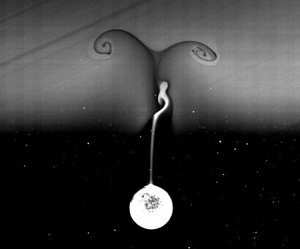Article contents
Bouncing behaviour of a particle settling through a density transition layer
Published online by Cambridge University Press: 16 October 2024
Abstract

The present work focuses on a specific bouncing behaviour as a spherical particle settles through a density interface in the absence of a neutral buoyant position. This behaviour was initially discovered by Abaid et al. (Phys. Fluids, vol. 16, issue 5, 2004, pp. 1567–1580) in salinity-induced stratification. Both experimental and numerical investigations are conducted to understand this phenomenon. In our experiments, we employ particle image velocimetry (PIV) to measure the velocity distribution around the particle and to capture the transient wake structure. Our findings reveal that the bouncing process begins after the wake detaches from the particle. The PIV results indicate that an upward jet forms at the central axis behind the particle following wake detachment. By performing a force decomposition procedure, we quantify the contributions from the buoyancy of the wake ( $F_{sb}$) and the flow structure (
$F_{sb}$) and the flow structure ( $F_{sj}$) to the enhanced drag. It is observed that
$F_{sj}$) to the enhanced drag. It is observed that  $F_{sb}$ contributes primarily to the enhanced drag at the early stage, whereas
$F_{sb}$ contributes primarily to the enhanced drag at the early stage, whereas  $F_{sj}$ plays a critical role in reversing the particle's motion. Furthermore, our results indicate that the jet is a necessary condition for the occurrence of the bouncing motion. We also explore the minimum velocities (where negative values denote the occurrence of bouncing) of the particle, while varying the lower Reynolds number
$F_{sj}$ plays a critical role in reversing the particle's motion. Furthermore, our results indicate that the jet is a necessary condition for the occurrence of the bouncing motion. We also explore the minimum velocities (where negative values denote the occurrence of bouncing) of the particle, while varying the lower Reynolds number  $Re_l$, the Froude number
$Re_l$, the Froude number  $Fr$, and the upper Reynolds number
$Fr$, and the upper Reynolds number  $Re_u$, within the ranges
$Re_u$, within the ranges  $1 \leqslant Re_l\leqslant 125$,
$1 \leqslant Re_l\leqslant 125$,  $115 \leqslant Re_u\leqslant 356$ and
$115 \leqslant Re_u\leqslant 356$ and  $2 \leqslant Fr\leqslant 7$. Our findings suggest that the bouncing behaviour is influenced primarily by
$2 \leqslant Fr\leqslant 7$. Our findings suggest that the bouncing behaviour is influenced primarily by  $Re_l$. Specifically, we observe that the bouncing motion occurs below a critical lower Reynolds number
$Re_l$. Specifically, we observe that the bouncing motion occurs below a critical lower Reynolds number  $Re^\ast _{l}=30$ in our experiments. In the numerical simulations, the highest value for this critical number is
$Re^\ast _{l}=30$ in our experiments. In the numerical simulations, the highest value for this critical number is  $Re^\ast _{l}=46.2$, which is limited to the parametric ranges studied in this work.
$Re^\ast _{l}=46.2$, which is limited to the parametric ranges studied in this work.
Information
- Type
- JFM Papers
- Information
- Copyright
- © The Author(s), 2024. Published by Cambridge University Press
References
- 1
- Cited by


